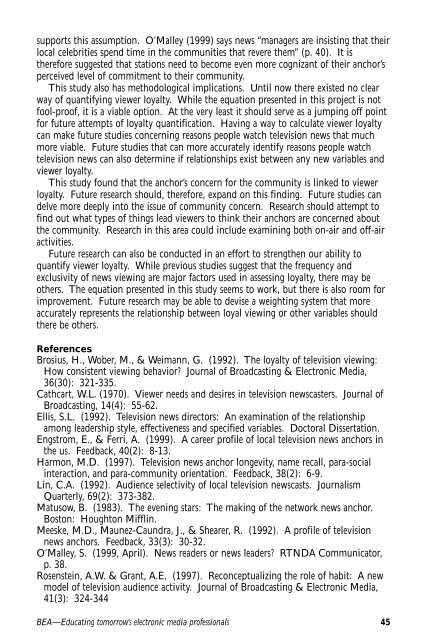APRILFeedback
Feedback April 2003 (Vol. 44, No. 2) - Broadcast Education ...
Feedback April 2003 (Vol. 44, No. 2) - Broadcast Education ...
- No tags were found...
You also want an ePaper? Increase the reach of your titles
YUMPU automatically turns print PDFs into web optimized ePapers that Google loves.
supports this assumption. O’Malley (1999) says news “managers are insisting that theirlocal celebrities spend time in the communities that revere them” (p. 40). It istherefore suggested that stations need to become even more cognizant of their anchor’sperceived level of commitment to their community.This study also has methodological implications. Until now there existed no clearway of quantifying viewer loyalty. While the equation presented in this project is notfool-proof, it is a viable option. At the very least it should serve as a jumping off pointfor future attempts of loyalty quantification. Having a way to calculate viewer loyaltycan make future studies concerning reasons people watch television news that muchmore viable. Future studies that can more accurately identify reasons people watchtelevision news can also determine if relationships exist between any new variables andviewer loyalty.This study found that the anchor’s concern for the community is linked to viewerloyalty. Future research should, therefore, expand on this finding. Future studies candelve more deeply into the issue of community concern. Research should attempt tofind out what types of things lead viewers to think their anchors are concerned aboutthe community. Research in this area could include examining both on-air and off-airactivities.Future research can also be conducted in an effort to strengthen our ability toquantify viewer loyalty. While previous studies suggest that the frequency andexclusivity of news viewing are major factors used in assessing loyalty, there may beothers. The equation presented in this study seems to work, but there is also room forimprovement. Future research may be able to devise a weighting system that moreaccurately represents the relationship between loyal viewing or other variables shouldthere be others.ReferencesBrosius, H., Wober, M., & Weimann, G. (1992). The loyalty of television viewing:How consistent viewing behavior? Journal of Broadcasting & Electronic Media,36(30): 321-335.Cathcart, W.L. (1970). Viewer needs and desires in television newscasters. Journal ofBroadcasting, 14(4): 55-62.Ellis, S.L. (1992). Television news directors: An examination of the relationshipamong leadership style, effectiveness and specified variables. Doctoral Dissertation.Engstrom, E., & Ferri, A. (1999). A career profile of local television news anchors inthe us. Feedback, 40(2): 8-13.Harmon, M.D. (1997). Television news anchor longevity, name recall, para-socialinteraction, and para-community orientation. Feedback, 38(2): 6-9.Lin, C.A. (1992). Audience selectivity of local television newscasts. JournalismQuarterly, 69(2): 373-382.Matusow, B. (1983). The evening stars: The making of the network news anchor.Boston: Houghton Mifflin.Meeske, M.D., Maunez-Caundra, J., & Shearer, R. (1992). A profile of televisionnews anchors. Feedback, 33(3): 30-32.O’Malley, S. (1999, April). News readers or news leaders? RTNDA Communicator,p. 38.Rosenstein, A.W. & Grant, A.E. (1997). Reconceptualizing the role of habit: A newmodel of television audience activity. Journal of Broadcasting & Electronic Media,41(3): 324-344BEA—Educating tomorrow’s electronic media professionals 45
















